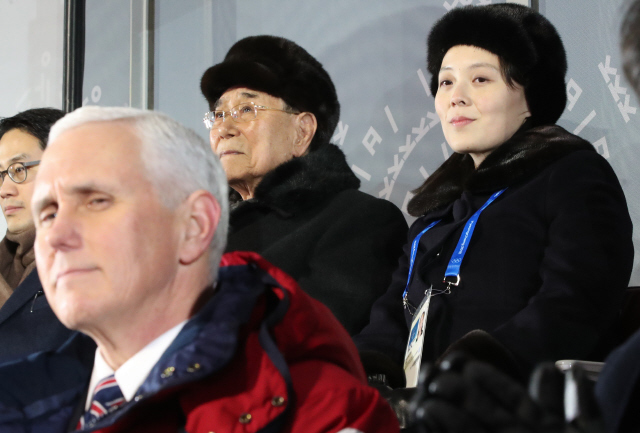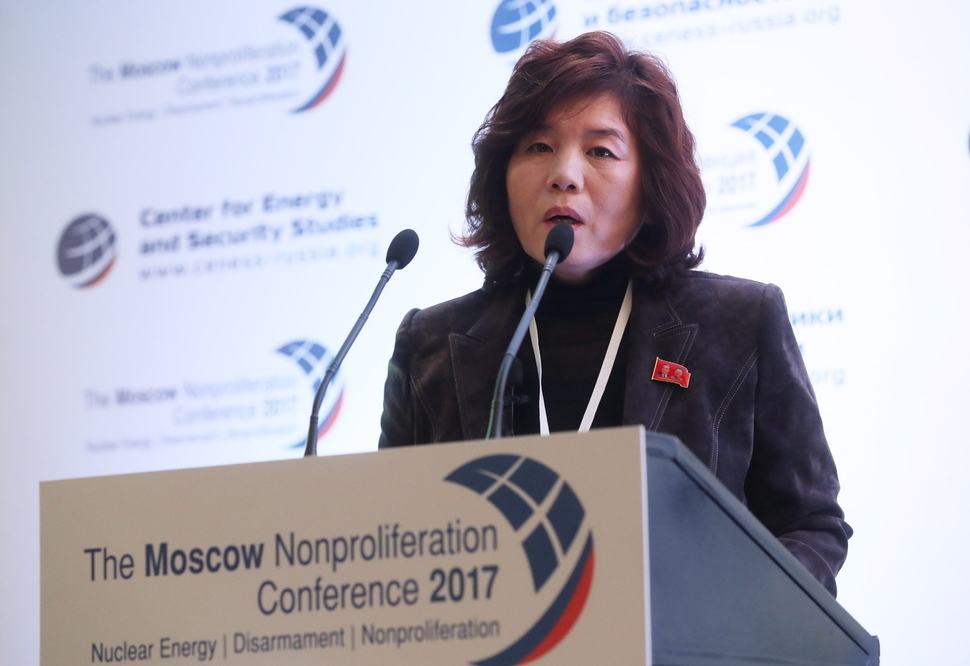 |
|
Kim Yo-jong, North Korean leader Kim Jong-un’s sister and first vice director of the Central Committee of the North Korean Workers’ Party (last row, right), president of the Presidium of the Supreme People‘s Assembly Kim Yong-nam (last row, left) and US vice president Mike Pence (front) observe the opening the ceremony of the 2018 PyeongChang Winter Olympics on Feb. 9.
|
North Korea’s statements cannot be read as unwillingness to participate in summit
US President Donald Trump sent a letter to North Korean leader Kim Jong-un stating that it would be “inappropriate, at this time, to have” their scheduled bilateral summit in Singapore on June 12. The “tremendous anger and open hostility displayed in your most recent statement” cited as a reason by Trump appeared to refer directly to a May 24 statement by North Korean Vice Foreign Minister Choe Son-hui, and more broadly to another statement on May 16 by First Vice Minister Kim Kye-gwan. Earlier that morning, Pyongyang had hinted at the possibility of “reconsidering” the summit in a statement by Choe, who represents its channel for working-level talks toward the North Korea-US summit. Choe’s statement was the second following a previous one on May 16 by Kim Kye-gwan, considered a symbolic figure in North Korea-US nuclear talks. It also came directly after a South Korea-US summit in Washington, DC. But the core message of the North’s two statements cannot really be read as signals of its unwillingness to participate in the North Korea-US summit. Soon after Choe’s statement, it went ahead with an event closing down its nuclear testing site at Punggye Village. Many analysts concluded on that basis that the aim of the statements was to stress Pyongyang’s “Maginot line” in terms of what it is unwilling to accept, while countering the influence of North Korea hardliners in the Trump administration. If the Washington Post was accurate in reporting that North Korea had not shown up for talks with the US for nearly two weeks, the possibility of some serious issue not addressed in the statements cannot be ruled out. Indeed, while the two statements coming eight days apart represented a single trend, they also showed subtle differences in emphasis – a reflection of Pyongyang’s own considerations and calculations. In terms of “reconsidering” the summit, Choe said in her statement that she planned to “put forward a suggestion to our supreme leadership for reconsidering the DPRK-US summit.” Her language was more specific than Kim Kye-gwan’s in his statement, where he suggested Pyongyang “cannot but reconsider our proceeding to the DPRK-US summit.” At the same time, both statements attached conditions to their warning – which suggested the North did not intend to back out first. Kim focused on issues related to the agenda and content of negotiations, warning that Pyongyang might reconsider the summit “if [the US] is trying to drive us into a corner to force our unilateral nuclear abandonment.” “The US is trumpeting as if it would offer economic compensation and benefit in case we abandon nuke [sic],” he wrote in the statement, adding that Pyongyang “will not at all make such a deal in future.” In contrast, Choe’s statement took issue mainly with Washington’s attitude, saying Pyongyang would reconsider the summit if the US “offends against our goodwill and clings to unlawful and outrageous acts.” Kim’s statement took aim at White House National Security Advisor John Bolton, Choe’s at Vice President Mike Pence. Both are considered leading North Korea hardliners in the Trump administration, insisting on a “Libyan model” of denuclearization ahead of any rewards. In his statement, Kim said the leaders in Pyongyang “do not hide our feelings of repugnance” toward Bolton.
 |
|
North Korean vice foreign minister Choe Son-hui
|







